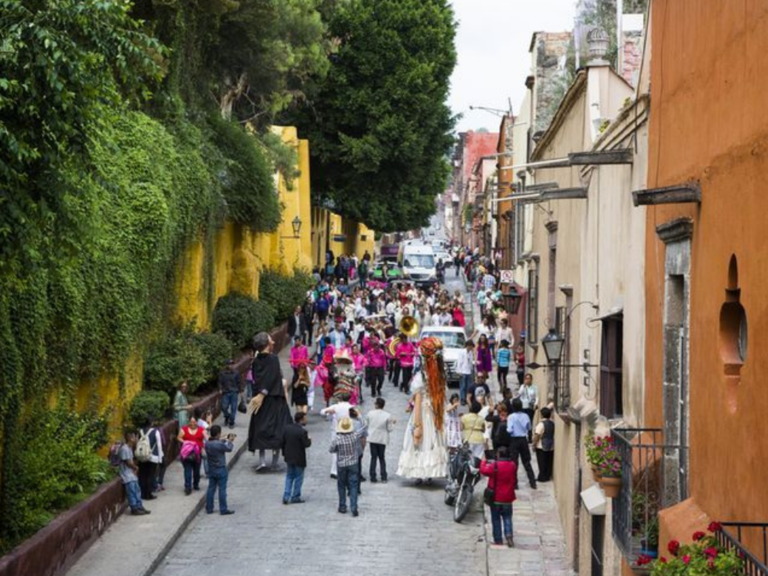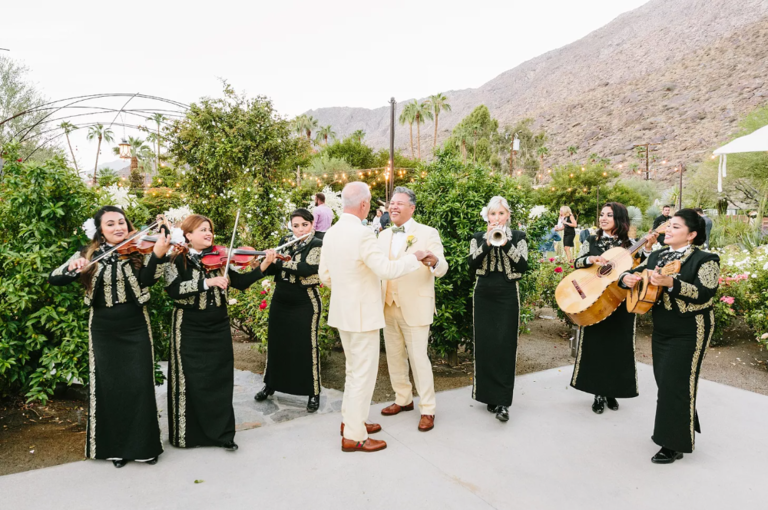The Essential Guide to Mexican Wedding Traditions for First-Time Guests
Local laws may restrict service availability to all. See the Equality Index for more information.
Mexican weddings are joyful, festive affairs steeped in tradition. If you've been invited to a traditional Mexican wedding as a first-time guest, there are a few customs and rituals you can expect to see at the destination wedding. Notably, many Mexican to-be-weds choose to tie the knot by celebrating Catholic nuptials. It's helpful to understand the meaning behind the elements you may see included in a Catholic Mexican wedding ceremony and the festive wedding reception that will follow. Below, Angelina Cardenas, owner of Angelina Cardenas Events in Tulum, Mexico, shares her insights about the Mexican wedding traditions you should know about ahead of the wedding day.
In this article:
- Traditional Mexican Wedding FAQs
- Los Padrinos y Madrinas
- Catholic Mass Wedding Ceremony
- Lasso Ritual
- Las Arras Matrimoniales
- Presentation of the Bouquet
- La Callejoneada
- Mariachi Band
- Mexican Wedding Reception Traditions for Food
- Special Dances
- Tornaboda
Traditional Mexican Wedding FAQs
What should I wear to a Mexican wedding?
Guests should wear clothes appropriate for church on the wedding day. If you're wearing a dress, make sure it covers your shoulders or bring a bolero, shawl or jacket to wear on top. A suit or slacks with a collared shirt and tie are generally a safe bet. However, when in doubt, refer to the wedding invitation for dress-code instructions. Mexican wedding receptions are generally more casual than the wedding ceremony so you don't need to stay as dressed up for the post-ceremony celebration. Some attendees may don a guayabera which is a linen buttondown shirt with short sleeves. As for the to-be-weds, a bride may pair a mantilla, or Spanish veil with an intricate lace border, with her wedding dress while a groom would likely sport a suit.
Who typically pays for the wedding in Mexico?
Historically, los padrinos y madrinas would cover many of the wedding expenses. In modern Mexican culture, a variety of people, from parents to the couple themselves, may contribute to the budget. Before getting too far into the wedding-planning process, it is important for everyone involved in the planning process to have a frank conversation about expectations.
What is a traditional Mexican wedding gift?
While the wedding sponsors will likely gift the couple a special kneeling pillow, prayer book and set of rosary beads, other wedding guests should stick to giving gifts from the registry or money to the to-be-weds.
Los Padrinos y Madrinas
Los Padrinos y Madrinas are wedding sponsors or people chosen by the to-be-weds to handle some of the wedding details. Generally, a married couple, sometimes godparents to the to-be-weds or other family members, will take on this role and shepherd the engaged couples through their wedding-planning journey toward becoming newlyweds.
These wedding sponsors generally help pay for the wedding and also present the couple with a variety of gifts. Usually, they'll gift the to-be-weds a set of rosary beads and a kneeling pillow that can be used during the Catholic wedding ceremony. Cardenas notes that these individuals often "take care of some ceremony details such as arras, rings, bouquet, el lazo and participate during this moment. For the reception, they also often gift many of the night's elements to the couple like the cake, photographer, music and liquor."
Catholic Mass Wedding Ceremony
Traditionally, Mexican couples will tie the knot with a mass in the Catholic church. A Catholic priest will preside over the wedding ceremony, oversee the exchange of rings and vows, and offer a blessing to the couple. During a wedding mass in the Catholic church, the liturgy of the Eucharist, or communion, will take place. However, wedding guests who are not members of the Catholic church are asked to refrain from taking part in this religious practice.



Lasso Ritual
In Mexican culture, the wedding lasso ritual involves draping a lasso, which is really more of a string or could even be made of rosary beads, around the to-be-weds as a symbol of their unity. Cardenas explains that this ritual represents "the couple becoming one unit."
Las Arras Matrimoniales
Las arras matrinoniales are wedding coins. During the wedding coin ritual, gold coins, which are generally stored in an ornate box, are exchanged between the couple as a symbol of prosperity. Historically, the groom would offer the coins to the bride to show that he would be able to "provide for the family financially and the bride will protect and take care of it."
Presentation of the Bouquet
A key element in Catholic wedding ceremonies in Mexico is the presentation of a bouquet to the Virgin Mary, the mother of Jesus. During the presentation of the bouquet, the couple will pray to the Virgin Mary and ask for her intercession in their union. Cardenas explains that "a flower bouquet for the Virgin Maria is a must," at Mexican weddings.
La Callejoneada
The wedding parade isn't traditional in all parts of Mexico, however, in some regions, it's common for a wedding parade to take place in the streets following the ceremony. Similar to a Second Line parade in New Orleans, the couple and their guests will parade through town to celebrate their nuptials. "In the south of Mexico there isn't this tradition," explains Cardenas. "This generally takes place in San Miguel where the streets are large."
Mariachi Band
Sometimes a mariachi band will perform at a Mexican wedding. Couples may hire these musicians to perform special songs throughout the celebration.
Mexican Wedding Reception Traditions for Food
Mexican wedding receptions will generally include a menu packed with tasty foods, like tamales, tacos with fresh tortillas, pork carnitas, enchiladas, and more. Generally, there will be a big variety in what's offered with multiple types of meat and sauces on the menu.
When it comes to bar menu, local Mexican beers and tequilas will likely be on offer, as will fresh margaritas. As a non-alcoholic option, agua fresca, in flavors like horchata, tamarind and limon, may be served.
As for dessert, polvorones or Mexican wedding cookies may be served. However, Cardenas notes that Mexican wedding cookies aren't as traditional as many people assume. A wedding cake, frequently a tres leches cake, buñueloas and pan dulce are other sweets that may make an appearance.
Special Dances
To kick off the party, the couple may share the first dance on the dance floor. At some point in the evening, you can expect to experience a dance known as la vibora de la mar or the sea snake dance. Cardenas explains that during la vibora de la mar, guests will hold onto each other and move about the dance floor before snaking under an arch formed by the newlyweds' hands. "The couple is in the center of the dance floor, hands up and together. Guests form a line holding the waist of the guests you have in front and dance and pass under the arch formed by the couple." A dance known as the money dance may also take place during the wedding reception.
Tornaboda
The couple, along with their wedding party and loved ones, will likely partake in a festive afterparty known as tornaboda. This is generally a slightly more intimate gathering and may even take place the following day.




























